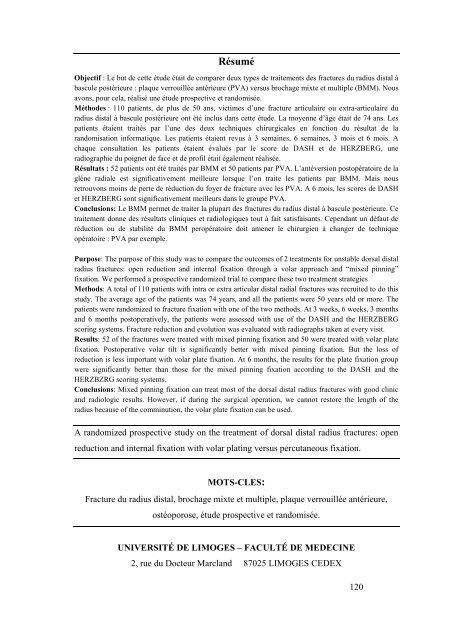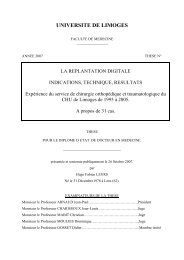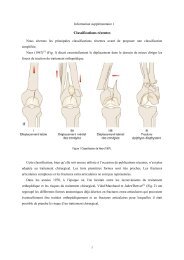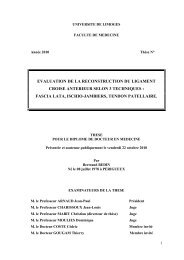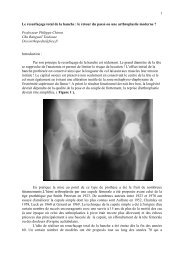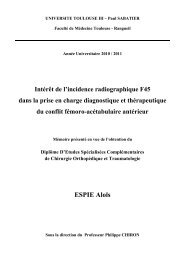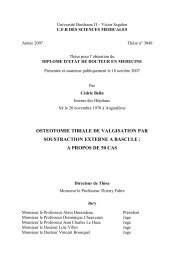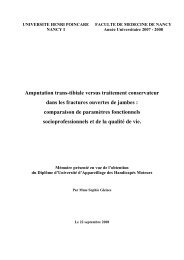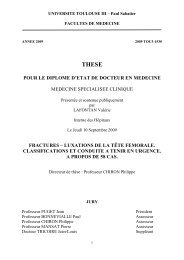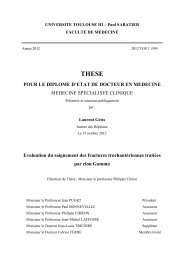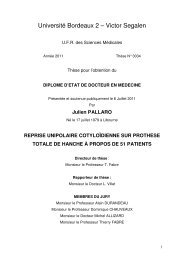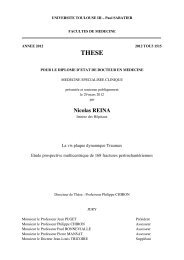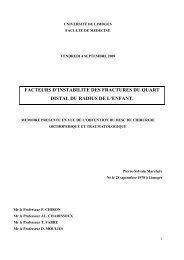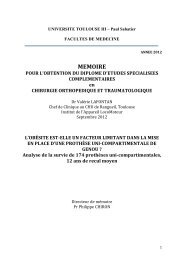Pierre Sylvain Marcheix - desc orthopedie
Pierre Sylvain Marcheix - desc orthopedie
Pierre Sylvain Marcheix - desc orthopedie
Create successful ePaper yourself
Turn your PDF publications into a flip-book with our unique Google optimized e-Paper software.
Résumé<br />
Objectif : Le but de cette étude était de comparer deux types de traitements des fractures du radius distal à<br />
bascule postérieure : plaque verrouillée antérieure (PVA) versus brochage mixte et multiple (BMM). Nous<br />
avons, pour cela, réalisé une étude prospective et randomisée.<br />
Méthodes : 110 patients, de plus de 50 ans, victimes d’une fracture articulaire ou extra-articulaire du<br />
radius distal à bascule postérieure ont été inclus dans cette étude. La moyenne d’âge était de 74 ans. Les<br />
patients étaient traités par l’une des deux techniques chirurgicales en fonction du résultat de la<br />
randomisation informatique. Les patients étaient revus à 3 semaines, 6 semaines, 3 mois et 6 mois. A<br />
chaque consultation les patients étaient évalués par le score de DASH et de HERZBERG, une<br />
radiographie du poignet de face et de profil était également réalisée.<br />
Résultats : 52 patients ont été traités par BMM et 50 patients par PVA. L’antéversion postopératoire de la<br />
glène radiale est significativement meilleure lorsque l’on traite les patients par BMM. Mais nous<br />
retrouvons moins de perte de réduction du foyer de fracture avec les PVA. A 6 mois, les scores de DASH<br />
et HERZBERG sont significativement meilleurs dans le groupe PVA.<br />
Conclusions: Le BMM permet de traiter la plupart des fractures du radius distal à bascule postérieure. Ce<br />
traitement donne des résultats cliniques et radiologiques tout à fait satisfaisants. Cependant un défaut de<br />
réduction ou de stabilité du BMM peropératoire doit amener le chirurgien à changer de technique<br />
opératoire : PVA par exemple.<br />
Purpose: The purpose of this study was to compare the outcomes of 2 treatments for unstable dorsal distal<br />
radius fractures: open reduction and internal fixation through a volar approach and “mixed pinning”<br />
fixation. We performed a prospective randomized trial to compare these two treatment strategies<br />
Methods: A total of 110 patients with intra or extra articular distal radial fractures was recruited to do this<br />
study. The average age of the patients was 74 years, and all the patients were 50 years old or more. The<br />
patients were randomized to fracture fixation with one of the two methods. At 3 weeks, 6 weeks, 3 months<br />
and 6 months postoperatively, the patients were assessed with use of the DASH and the HERZBERG<br />
scoring systems. Fracture reduction and evolution was evaluated with radiographs taken at every visit.<br />
Results: 52 of the fractures were treated with mixed pinning fixation and 50 were treated with volar plate<br />
fixation. Postoperative volar tilt is significantly better with mixed pinning fixation. But the loss of<br />
reduction is less important with volar plate fixation. At 6 months, the results for the plate fixation group<br />
were significantly better than those for the mixed pinning fixation according to the DASH and the<br />
HERZBZRG scoring systems.<br />
Conclusions: Mixed pinning fixation can treat most of the dorsal distal radius fractures with good clinic<br />
and radiologic results. However, if during the surgical operation, we cannot restore the length of the<br />
radius because of the comminution, the volar plate fixation can be used.<br />
A randomized prospective study on the treatment of dorsal distal radius fractures: open<br />
reduction and internal fixation with volar plating versus percutaneous fixation.<br />
MOTS-CLES:<br />
Fracture du radius distal, brochage mixte et multiple, plaque verrouillée antérieure,<br />
ostéoporose, étude prospective et randomisée.<br />
UNIVERSITÉ DE LIMOGES – FACULTÉ DE MEDECINE<br />
2, rue du Docteur Marcland 87025 LIMOGES CEDEX<br />
120


